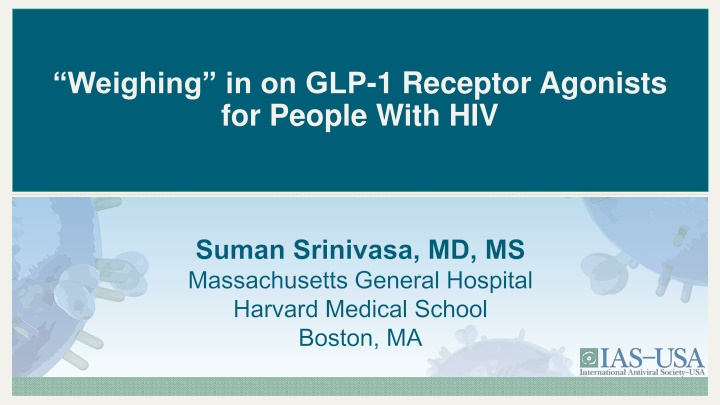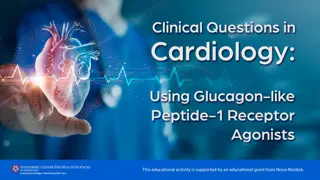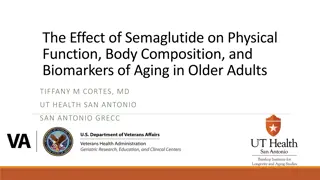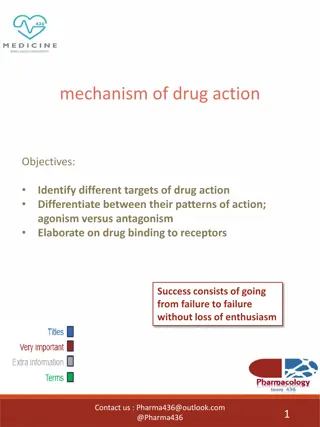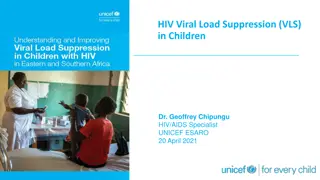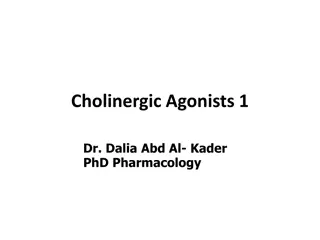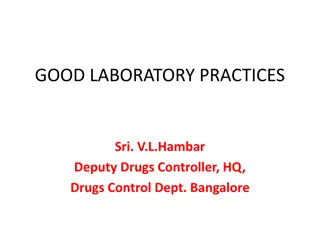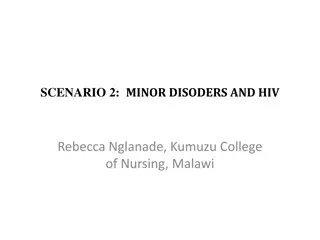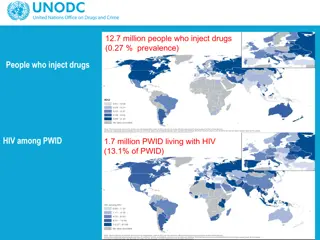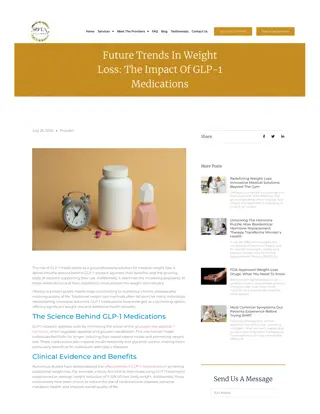GLP-1 Receptor Agonists in HIV: Addressing Weight Gain Challenges
GLP-1 receptor agonists offer a promising therapeutic approach for weight management in individuals with HIV. Weight gain is a common issue, exacerbated by antiretroviral therapy, and can lead to metabolic risks. This presentation by Dr. Suman Srinivasa discusses the potential of GLP-1 receptor agonists, recent studies on their use in HIV patients, and their off-target benefits. The session highlights the importance of addressing weight gain in the HIV population and explores the role of GLP-1RAs in managing body composition for weight loss.
Download Presentation

Please find below an Image/Link to download the presentation.
The content on the website is provided AS IS for your information and personal use only. It may not be sold, licensed, or shared on other websites without obtaining consent from the author.If you encounter any issues during the download, it is possible that the publisher has removed the file from their server.
You are allowed to download the files provided on this website for personal or commercial use, subject to the condition that they are used lawfully. All files are the property of their respective owners.
The content on the website is provided AS IS for your information and personal use only. It may not be sold, licensed, or shared on other websites without obtaining consent from the author.
E N D
Presentation Transcript
Weighing in on GLP-1 Receptor Agonists for People With HIV Suman Srinivasa, MD, MS Massachusetts General Hospital Harvard Medical School Boston, MA
Financial Relationships With Ineligible Companies (Formerly Described as Commercial Interests by the ACCME) Within the Last 2 Years Dr Srinivasa reported receiving research grant funding from Gilead Sciences. (Updated November 13, 2023) Slide 2
Learning Objectives On completion of this activity, learners will be able to: Implement GLP-1 receptor antagonists (GLP-1RAs) as a novel therapeutic class for weight loss Summarize recent studies of GLP-1RA use among people with HIV Describe off-target effects of GLP-1RAs, which may be of potential benefit to the HIV population Slide 3
Outline Weight gain among persons with HIV (PWH) Therapeutic potential of GLP-1 receptor agonists (GLP-1RAs) in diabetes and weight loss Importance of body composition in weight loss Studies of GLP-1RAs in HIV Off target benefits of GLP-1RAs Slide 4
Weight gain in the era of contemporary ART Weight gain has been associated with ART initiation and generally does not improve with switching ART regimens. The NA-ACCORD study demonstrated that after 3 yrs of ART: almost 1/5 of those who were normal weight became overweight and 1/5 of those who were overweight became obese. The ADVANCE study demonstrated that among ART-treated individuals, women with HIV gain more weight than men with HIV. Pooled analysis of 8 RCTs of treatment-naive PWH initiating ART reported a higher weight gain in those receiving INSTI or TAF-containing regimens than in those receiving TDF, abacavir or zidovudine. Dolutegravir and bictegravir have been most consistently implicated with INSTI-associated weight gain Additional risk factors for weight gain include: low CD4 count, high viral load, black race Slide 5 Godfrey, JID 2019; Koethe, Nature Reviews 2020; Koethe, AIDS Res Hum Retro 2016; Koethe, HIV Med 2015; Sax, CID 2019; Bourgi, CID 2020; Bares, J Women Health 2018
Weight gain after ART initiation and metabolic risk Participated were included were on any of the following antiretrovirals: tenofovir disoproxil fumarate emtricitabine lamivudine abacavir efavirenz atazanavir darunavir raltegravir Adjusted Cox Proportional Hazard Models of Weight Change at Week 48 and Subsequent Clinical Events Among Participants With 10% Weight Gain Clinical Event HR (95% CI) 2.01 (1.30, 3.08) 2.02 (1.55, 2.62) 1.54 (1.22, 1.95) Diabetes mellitus (n=130) Metabolic syndrome (n=360) Cardiometabolic event (n=424) Mean weight gain from 0 48 weeks: 3.6 kg (SD 7.3) Participants who lost more than 5% of their baseline weight had a lower risk of incident metabolic syndrome: HR 0.67, 95% CI [0.42, 1.07]. Slide 6 Bares, CID 2023
GLP-1 receptor agonists (GLP-1RAs): Mechanism of Action Suppress appetite Slow gastric emptying Stimulate insulin secretion Inhibit glucagon release GLP-1 receptor agonism Decrease glucose production Slide 7 Figure adapted from Cignarelli, Front Endo 2022 and myendoconsult.com
Broad Potential Benefits of GLP-1RAs Cardioprotection Increase cardiac output Improve endothelial function Increase glucose uptake Increase diuresis Increase natriuresis Decrease hepatic steatosis Increase glucose uptake Decrease lipogenesis Increase lipolysis Slide 8 Figure adapted from Cignarelli, Front Endo 2022 and myendoconsult.com
GLP-1RAs: Preparations and FDA Indications Name Route Frequency Max Dosing FDA Indication Weight Loss SQ weekly 2.4mg Semaglutide (Wegovy) Semaglutide (Ozempic) Semaglutide (Rybelsus) Liraglutide (Saxenda) Liraglutide (Victoza) Dulaglutide (Trulicity) Exenatide ER (Bydureon) Exenatide (Byetta) Lixisenatide (Adylxin) SQ weekly 2.0mg Type 2 Diabetes GLP-1RA Long acting PO (30min before eating) SQ daily 14mg Type 2 Diabetes daily 3.0mg Weight Loss SQ daily 1.8mg Type 2 Diabetes SQ weekly 4.5mg Type 2 Diabetes SQ weekly 2.0mg Type 2 Diabetes SQ BID 10mcg Type 2 Diabetes GLP-1RA Short acting SQ daily 20mcg Type 2 Diabetes Slide 9
GLP-1RAs: Efficacy on HbA1c/co-morbidities among individuals with DM Name Route Frequency Max Dosing Reduction in HbA1c% points Cardiovascular mortality benefit in existing/ high risk CVD Nephropathy benefit SQ weekly 2.0mg -1.5 to -2.0 Semaglutide (Ozempic) Semaglutide (Rybelsus) Liraglutide (Victoza) Dulaglutide (Trulicity) Exenatide ER (Bydureon) Exenatide (Byetta) Lixisenatide (Adylxin) PO daily 14mg -0.7 to -2.0 SQ daily 1.8mg -0.8 to -1.5 SQ weekly 4.5mg -1.0 to -1.5 SQ weekly 2.0mg -1.5 to -1.6 SQ BID 10mcg -1.0 SQ daily 20mcg -0.8 to -1.0 Slide 10
STEP8 Trial: Efficacy on weight loss Results from the STEP 8 Trial (n=338) overweight/obese without DM (68 weeks) 0 Absolute Mean Weight Change (95% CI): -2 -1.9% Mean Weight Change (%) -4 Semaglutide 2.4mg: -15.3 (-17.3 to -13.4)kg Liraglutide 3.0mg: -6.8 (-8.8 to -4.9)kg -6 -6.4% -8 -10 Participants Achieving >10%, >15%, >20% weight loss: -12 -14 Semaglutide 2.4mg: 70.9%, 55.6%, 38.5% Liraglutide 3.0mg: 25.6%, 12.0%, 6.0% -16 -15.8% -18 Semaglutide (n=126) Liraglutide (n=127) Placebo (n=85) Slide 11 Rubino, JAMA 2022
SELECT Trial: CV outcomes in obesity without DM Results from the SELECT Trial (n=17,604) BMI 27, Pre-existing CVD, No known DM Mean duration exposure to semaglutide: 34.2 13.7 months Mean duration follow up: 39.8 9.4 months Primary CV endpoint (composite death from CV causes, nonfatal MI, or nonfatal CVA) 6.5% in the semaglutide SQ group 8.0% in the placebo group *20% risk reduction with semaglutide SQ Slide 12 Lincoff, NEJM 2023
OASIS-1 Trial: Oral Semaglutide 50mg for weight loss Results from the OASIS-1 Trial (n=338) BMI>30 or BMI>27 + weight related complications. No known DM Mean weight change with semaglutide 50mg PO vs. placebo after 68 weeks: -15.1% vs. -2.4% Increased GI adverse effects were reported in the semaglutide vs. placebo groups: 80% vs. 45% A trend towards a higher reduction in hsCRP was seen in semaglutide vs. placebo treated groups: -57% vs. -14% *Semaglutide 50mg--currently under investigation Slide 13 Knop Lancet 2023
GLP-1RA: Current Clinical Indications for Patients Clinical Indications for GLP-1RAs With established atherosclerotic CVD (ASCVD) or kidney disease Type 2 Diabetes Mellitus* Without established ASCVD or kidney disease and HbA1c>9% Without established ASCVD or kidney disease and HbA1c 9%, but weight gain is a concern Obesity BMI 30 kg/m2 BMI of 27 to 29.9 kg/m2with weight-related comorbidities + not met weight-loss goals (5% loss of total body weight over 3-6 months) with comprehensive lifestyle intervention alone *Not for use in type 1 diabetes Slide 14
GLP-1RA: Potential Adverse Side Effects Injections site reactions Risk of hypoglycemia is low (may occur when used in combo with sulfonylureas, insulin, glinides) Gastrointestinal: nausea, vomiting, diarrhea (most common, reported in 10-50%) Symptoms may lessen with duration of therapy and dose titration Pancreatitis Use is contraindicated if prior history of pancreatitis Biliary disease: cholelithiasis, cholecystitis Acute renal insufficiency (infrequent, usually in setting of GI symptoms) Medullary thyroid cancer (black box warning) Use is contraindicated with personal/family history Slide 15
GLP-1RAs: More about Potential Malignancy Risk Several meta-analyses indicated that GLP-1RAs did not increase the risk of malignancy In 2021, STEP 3 and STEP 4 trials reported the incidence of malignancy in obese adults as 1.1% (6/535) in the semaglutide group and 0.4% (1/268) in the control group Yang et al. explored the association of GLP1RA and neoplasms by mining the FDA Adverse Event Reporting System (FAERS) database GLP-1RA did not cause a disproportionate increase in all tumor cases. Significant signals were detected between GLP-1RA and certain tumors--including thyroid cancers, pancreatic neoplasms, and neuroendocrine tumors Slide 16 Cao, 2019; Liu, 2019; Elashoff, 2011; Wadden,2021; Rubino, 2021; Yang, Frontiers Pharm 2022
Combination GLP-1RAs: Twincretins and beyond Role of Gut Hormone Co-agonists and Potential Synergistic Effects GIP Glucagon increase appetite yes Appetite Suppression Slow Gastric Emptying Stimulate Insulin Secretion Glucagon Inhibition Decrease Glucose Production Other no effect yes yes yes Increase glucagon Indirect effects through glucagon -- -- Increase glucose production Lipolysis, increased energy expenditure, may activate GLP-1R Slide 17 Brandt, J Int Med 2018; Rosenstock, Lancet 2023; Nogueiras, Nature Metab 2023
Discerning Phenotypes with Excess Adiposity in HIV SAT VAT *Ideal Clinical Strategy: *Ideal Clinical Strategy: Reduce VAT Preserve SAT Reduce VAT Reduce SAT Growth hormone releasing hormone analogue (tesamorelin) ? GLP1 receptor agonism Slide 18 Adapted from Depres 2012; Godfrey JID 2019
Weight Loss with GLP-1As: fat vs. lean mass With the use of contemporary ART, the HIV population is aging and the prevalence of frailty is increased. Sarcopenia risk may be 6-fold higher among PWH when compared to matched individuals without HIV. In addition, sarcopenia may occur at a younger age among PWH. In the STEP 1 trial (semaglutide SQ weekly), an exploratory analysis showed: %change body weight from baseline to week 68 was: -15.0% with semaglutide vs -3.6% with placebo. In the semaglutide group: Relative total fat mass decreased -19.3% Relative regional visceral fat mass decreased -27.4% However, the proportion of total lean body mass relative to total body mass increased by 3.0%-points. Increasing improvement in lean body mass:fat mass ratio was seen with semaglutide with increasing weight loss. Relative total lean body mass decreased -9.7% *Ideal Clinical Strategy: Preserve Lean Body Mass Slide 19 Erlandson, Top Antiviral Med 2020; Oliveria, Euro J Clinic Nut 2020; Wilding, JES 2021
Do people living with HIV lose weight on GLP-1RA therapy? Breakdown of weight changes with GLP-1RA use Retrospective study assessing GLP-1RA initiation on weight and HbA1c among persons with HIV, n=35 (LSU) 100% 26% gained weight (n=9) 90% 80% 9% stable weight (n=3) Baseline Characteristics Mean BMI (SD): 35.7 (9.8) kg/m2 Mean HbA1c (SD): 9.5 (2.6) % INSTI use: 89% Concurrent use of metformin: 57% 70% o 60% 50% o 66% lost weight (n=23) 40% o 30% o 20% 10% 0% Mean duration GLP-1RA use (SD): 20.6 (14.0) months 9/20 (45%) PWH with duration use >12 months lost >5% body weight Slide 20 Tauhid, OFID 2022 Dec; 9(Suppl 2): ofac492.518/ ID Week 2022
GLP-1 RAs Promote Weight Loss Among People With HIV Retrospective study assessing the impact of GLP-1RA initiation on weight, BMI and HbA1c, n=225 (UCSD) Preparations included: semaglutide (60%--53% SQ/7% PO), liraglutide (3%), dulaglutide (31%), tirzepatide (6%) 41% achieved maximal dosing; mean duration on GLP-1RA :15.4 (4.5-26.4) months Slide 21 Adapted from slides Nguyen, ID Week 2023
GLP-1 RAs Promote Weight Loss Among People With HIV 53 PWH (24%) had >5% weight loss 41 PWH (18%) transitioned from the obese to overweight category Factors associated with >5% weight loss Higher baseline BMI: OR 1.07 (1.02-1.3) Longer duration of treatment (months): OR 1.04 (1.01-1.07) The use of dulaglutide was associated with decreased odds of achieving >5% weight loss [OR 0.33 (0.17-0.66)] as compared to the other GLP-1 RAs. Slide 22 Adapted from slides Nguyen, ID Week 2023
Impact of GLP-1RAs on body weight in patients with type 2 diabetes and HIV Retrospective study assessing the impact of GLP-1RAs on metabolic outcomes in individuals with type 2 diabetes mellitus and HIV (DM+HIV) compared to DM without HIV (DM), n=45 (University of Cincinnati) DM+HIV (n=15) -10.4 (12.5) kg -8.0 (10.0) % 60% -1.3 (2.4) DM (n=30) -1.7 (8.5) kg -1.5 (6.8) % 33% -0.5 (2.0) Mean Change Weight (SD) * Mean %Change Weight (SD) * Achieved >5% weight loss Mean Change HbA1c (SD) *significantly different Conclusion: PWH and DM had significantly greater weight loss compared to people with DM alone. Slide 23 Lloyd, IAS 2023: https://programme.ias2023.org/Abstract/Abstract/?abstractid=3399
Effects of Semaglutide in HIV-Associated Lipohypertrophy Randomized, double-blind, placebo-controlled study of semaglutide SQ vs. placebo (full max dose 24 weeks) among PWH with BMI 25 and increased waist circumference, n=108 (Case Western/Medical University of South Carolina) Primary Endpoint: VAT by CT; Other endpoints: weight, SAT by CT, DXA for total fat, limb fat, trunk fat, lean mass Slide 24 Adapted from slides McComsey, ID Week 2023
Effects of Semaglutide in HIV-Associated Lipohypertrophy For every 1% lean mass reduction, the semaglutide group lost 2.4% fat mass and the placebo group gained 2.0% fat mass No improvement in pericardial or liver fat Overall excellent adherence, study-related AEs similar between groups; only 3 AEs lead to discontinuation Slide 25 Adapted from slides McComsey, ID Week 2023
Other Ongoing Studies of GLP-1RAs in HIV Semaglutide's Efficacy in Achieving Weight Loss for Those With HIV (SWIFT) University College Dublin Persons with BMI 30kg/m2 or BMI 27kg/m2 and hypertension, dyslipidemia or type 2 diabetes mellitus randomized to semaglutide+diet/exercise vs. diet/exercise (open label) Outcome: Effect on total body weight Other measures: immune function, inflammation, gut microbiome, glucose and lipid metabolism Slide 26 Clinicaltrials.gov
Potential Interactions between GLP-1RAs and ARTs GLP-1RAs are not expected to pose significant drug interactions via their metabolism (degraded by endopeptidases) GLP-1RAs are known to inhibit gastric acid secretion and to delay gastric emptying Treatment with liraglutide reduced gastric acid secretion by 18.7% and prolonged gastric emptying time by 25 min. The dissolution and absorption of atazanavir and oral rilpivirine may be affected by elevated gastric pH. With such a small difference in gastric acid secretion and emptying time though, GLP-1RAs are thought to have a minimal effect. A separated intake of orally administered GLP-1RA by 4 hrs before oral rilpivirine, and by 2 4 hrs before atazanavir intake, has been recommended Slide 27 Zino, HIV Med 2023; Quast, Diabetes Care 2020;Cope, Pharmacotherapy 2019
Semaglutide in NASH RCT conducted at 96 sites enrolling patients with/without DM, BMI>25, and biopsy- confirmed non-alcoholic steatohepatitis (NASH) were treated with semaglutide 0.1- 0.4mg vs. placebo over 72 weeks. (n=320) Treatment with semaglutide 0.4mg resulted in a significantly higher percentage of patients with NASH resolution vs placebo: 59 vs. 17% Mean percent weight loss was 13% in the semaglutide 0.4-mg group and 1% in the placebo group Slide 28 Newsome, NEJM 2021
Step-HFpEF: Semaglutide in HFpEF and Obesity Results from the Step-HFpEF Trial (n=338) Heart failure with preserved ejection fraction (HFpEF), BMI 30 Semaglutide 2.4mg SQ vs. placebo over 52 wks Among those with HFpEF and obesity, semaglutide led to: -larger reductions in symptoms and physical limitations -greater improvements in exercise function -greater weight loss Study was not powered to evaluate clinical events, such as hospitalization from HF Slide 29 Kosiborod, NEJM 2023
The role GLP-1RA in addictive disorders GLP-1 is also produced in the nucleus tractus solitarius of the brain stem and is released as a neurotransmitter GLP-1 receptors are expressed in brain regions involved in reward and addiction and its stimulation modulates dopamine (decreases dopamine) Preclinical research has identified potent reductions in substance use and attenuation of drug-seeking behavior with several different GLP-1RAs, mainly in rodent models Suppresses motivation to consume alcohol, alcohol-seeking behaviors, relapse drinking and withdrawal symptoms Suppresses nicotine intake and reward Decreases some opioid seeking and withdrawal symptoms Decrease cocaine and amphetamine reward, decrease cocaine intake Preliminary clinical studies of alcohol use disorder suggest that GLP-1RAs reduce alcohol consumption in a subset of individuals with obesity **Clinical studies are needed to assess the use of GLP-1RAs in addictive disorders. Jerlhag, Front Pharm 2023; Hernandez, Neuropyschpharm 2018; Hernandez, Addict Biol, 2019; Egecioglu, PLOS one, 2013; Egecioglu, Psychneuroendo, 2013; Marty, Front Neuro, 2020; Vallof, Addict Biol, 2015; Klausen JCI Inight, 2022; Tuesta, Nat Neurosci 2017; Douton, Behav Pharm 2021; Zhang, Neuorpsychopharm, 2020 Slide 30
Clinical Questions with GLP-1RAs Are these chronic medications? Is there reaccumulation of fat mass after GLP-1RA discontinuation? Will the amount of lean mass lost have significant clinical contributions to frailty? Will weight loss secondary to GLP-1RA use reduce metabolic risk among PWH? Are there cardiovascular, kidney, and liver benefits associated with GLP-1RA use among PWH? Will GLPs demonstrate efficacy in addiction disorders in human studies? Will there be increased insurance coverage for weight loss medications? Slide 31
